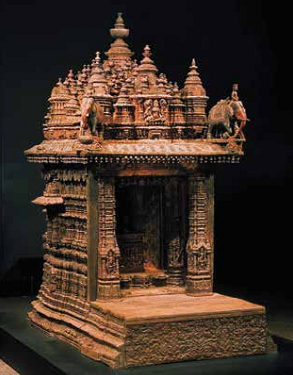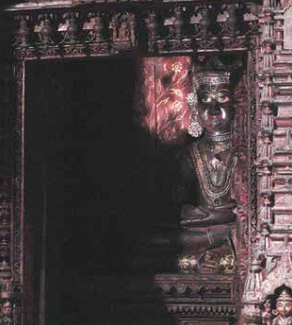
Centre of Jaina Studies Newsletter: SOAS - University of London
The Jaina domestic shrine in the collection of the Dahlem Museum in Berlin comes from Gujarat (Figure 1). The collector Robert Stolper bought this shrine in India and sold it to the Dahlem Museum in April 1966. In a letter dated February 1966 to Sir Härtel, director of the Museum, Robert Stolper writes: "I have received news that the temple [sic.] is on its way and I will contact you when it arrives."
This uncommon piece is very well preserved, and was recently restored. It dates from the eighteenth century and is made of teak wood. Comprised of a lot of different wood pieces, it has been put together with tenons and mortises. Only three front-walls are painted; we can suppose that the temple was displayed in the corner of a room, which could explain why not every panel was painted.
The shrine was made to receive the ritual objects on its platform. In the course of restoration, some pieces of food for offerings and wax from candles were discovered, indicating its usage in former times. The type of wood for the platform is different from that of the shrine itself. It has many fissures and looks older than the rest of the shrine. It possibly belonged to another piece of wooden furniture. The shrine's dimensions and sculptures show that it was the property of a rich Jaina merchant from Gujarat.

Figure 1. Jaina Domestic Shrine
18th Century, Gujarat
Teakwood
Objektnummer I 10037, Dahlem Museum
Image © Staatliche Museen zu Berlin

Figure 1. (Detail) Jaina Domestic Shrine, Neminatha
Image © Staatliche Museen zu Berlin, Museum für Asiatische Kunst
It has three main elements: the base, walls, and the roof. The first level the base is decorated with many sculpted friezes made of flowers, makara monsters, birds, elephants, and vegetal foliated scrolls. The goddess Sarasvati seats on the middle of the base. On the second level the walls also have decorated friezes: human faces, scale replicas of temples, and amalaka and makara monsters. Makara spit out vegetal creepers. The roof comprises a forest of domes, amalaka and small-scale temples disposed in superposed circles. Friezes offer a composition of superimposed horizontal lines.
The main entrance of the shrine is unique with its worship platform. It opens on the cellar. The cellar is dedicated to receive the statue of the Jina; the present Jina is a twentieth-century sculpture that replaced the original one. On the threshold of this entrance we can see two conches. In the lower part of the altar there is one wheel between two gazelles. The presence of the gazelles and the wheel is unusual on this type of shrine. The sculpture represents Neminatha, the twenty-second Jina, who is associated with the conch.
The pair of conches in front of the entrance of the shrine is an attribute of Neminatha and a recurrent decoration on the threshold of Jaina or Hindu temples and of shrines in Rajasthan and Gujarat. The combination of gazelles and a wheel is not an attribute of the twenty-second Jina, but rather a Buddhist symbol associated with the sixteenth Jina: Santinatha. The use of Buddhist symbols with a Jaina divinity was a way to continue to develop Jainism at a time when Jainism was not as widely practiced. It seems that for the shrine in Berlin the best identification is the one associated with the sixteenth Jina because of the presence of the wheel and the gazelles.
The present sculpture of Neminatha is from the twentieth century and is decorated with necklace and others jewels, evincing that it is a Svetembara image from western India. On the front wall of the shrine several Jinas appear on painted plaques made of wood. They stand in a meditation posture.
The second important goddess present on the shrine is the goddess Sarasvati. She appears three times on the walls. She is the Goddess of Knowledge and Arts and the wife of Brahma. She holds a water pot and an elephant hook, and wears a necklace and a pair of earrings. Her jewels show that this representation is Svetembara.
Gaja Lakshmi is recognizable by the two elephants on each part of her head. She wears a water pot, a rosary and several jewels. She symbolizes the wealth of the Jaina merchant community. Gaja Lakshmi always occupies the same location in the middle of the pediment on the Jaina domestic shrine.[1]
Different kinds of birds are depicted on the shrine. They are represented as a facing couple on the base and on the roof. Kirtimukha is a monster with horns and with vegetal foliage coming out from his mouth. We find them depicted on the friezes. Kirtimukha welcome the worshipper on the threshold in front of the entrance of the shrine. We find elephants face to face as a couple on the base and the architrave. Two blue elephants are represented on each side of the front wall; the different colour, the different types of wood and the holes on their stomachs indicate that they were pieces applied later.
The shrine appears to be a miniature stone temple. Its coposition includes a sacred chamber with Neminatha, a small room with pillars. In elevation it has three elements: the base, walls and roof. Its decoration and iconography are similar to the Adinath temple in Ranakpur. We find for instance the same conch on the threshold. The shrines are also influenced by wood temples such as the Jaina temple conserved in the museum of Cologne and the carved wooden ceiling in the collection of the Metropolitan Museum of Art in New York, which depicts Jinas, Lakshmi, and kirtimukha. The haveli in Rajasthan and Gujarat States are another influence for the shrine. These houses are painted wood houses. In the nineteenth century, rich Jaina merchants sponsored their construction on their land. But the trade has changed and the merchants had to move in big cities to earn their living. They therefore left the haveli, which are no longer extant. Some were restored and became art galleries or guest-houses.
The Jaina shrine is one of the two Jaina masterpieces at the Dahlem Museum. The second one is a painting depicting the pilgrimage of Satrunjaya, which is presently not on display. To exhibit of these two Jaina objects together would be interesting.
Anupana Delacour is a student at the University of La Sorbonne. Her reseach centres on Hindu and Jaina architecture. Her first MA thesis focused on the Jaina holdings of the Dahlem Museum of Berlin. Her second MA thesis deals with the Haveli in Rajasthan and Gujarat.
 Anupama Delacour
Anupama Delacour